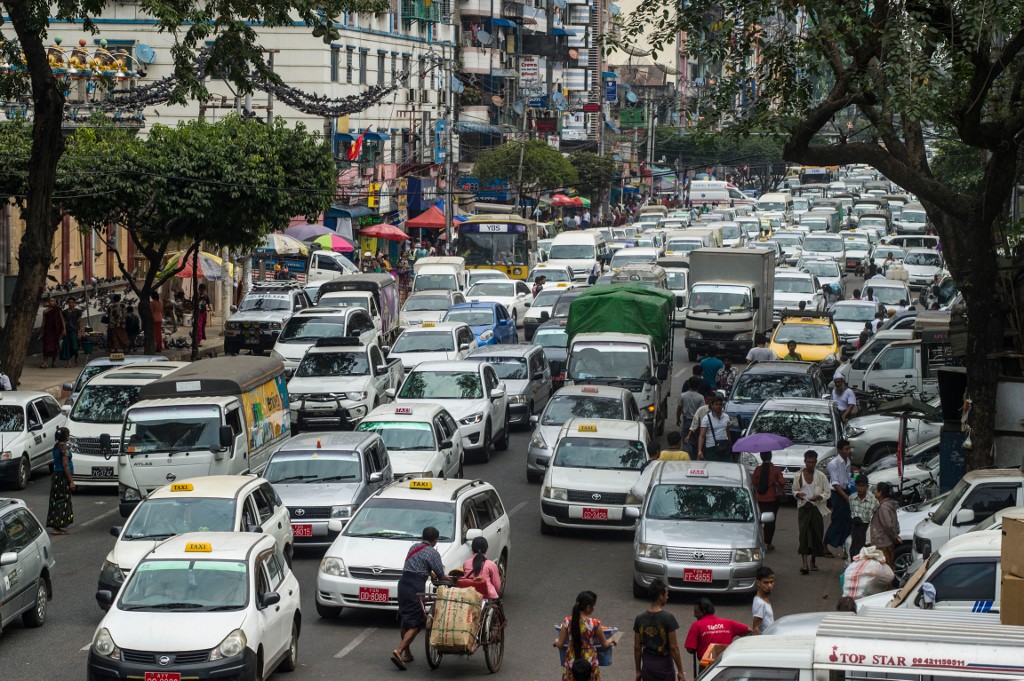
Air pollution rose to unhealthy levels in Yangon this morning in a worrying trend for public health.
The US embassy in Kamayut township at 8.30am recorded an air quality index (AQI) of 188, which indicates a level of air quality where "everyone may begin to experience health effects.”
Meanwhile, the US state’s air monitor in Bangkok recorded a lower level of 109 in the “unhealthy for sensitive groups” range.
Recent Yangon AQI figures have prompted Myanmar’s Department of Meteorology and Hydrology to release its own data from its Kabar Aye weather station north of Inya Lake for the first time.
Levels remained moderate, or from 50-100, on February 10-16, according to a Facebook post from the department, whereas other sensors had recorded higher levels.
The department’s director general Dr Kyaw Moe Oo downplayed fears of dirty air in state media today, saying cities such as Beijing and Bangkok were “much worse.”
Yangon’s average AQI for fine particulate matter (PM2.5) often hovers around 100 based on data from the US embassy and Air Quality Yangon, a volunteer group that monitors air pollution, said the group’s head, Dr Kirt Page.
But a look at recent data indicates a spike, he said.
“A first glance at the data suggests that there have been more 'bad air' days this winter compared to the last, but a deeper analysis must be performed to confirm this,” Page told Myanmar Mix.
Yangon recently had cold spells that may have resulted in a cold blanket of air known as a thermal inversion layer that trapped pollutants, he explained.
“That could be one contributing factor as to why we are seeing a little bit worse air these days,” he added.
Environmental group Advancing Life and Regenerating Motherland (ALARM) executive director Win Myo Thu urged policy makers to take action because “the trend of air pollution is getting worse,” he said.
“Who is responsible? It’s not clear. Is it the job of environmental department, the Yangon development committee, the ministry of health, or the ministry of industry? A lot of co-ordination is required,” he said.
Myanmar Mix contacted Dr Aung Myint Maw, director of Yangon municipal body’s environmental management. He declined to answer the questions, saying they needed two days to measure the pollution.
When contacted again after two days, Dr Aung Myint Maw said he was “not involved in the project” and suggested to contact the meteorology department.
The department along with a representative of the health and sports ministry were unavailable for comment.
Tackling air pollution would mean improving the quality of diesel used by cars, said Win Myo Thu. Burning rubbish and construction sites are also widely cited as a cause of dirty air.
The city also needs more air monitoring sensors for an accurate picture of the air quality, he said.
“Another problem is locally owned medium-sized factories,” he said, explaining that their use of coal adds to pollution.
Harsh restrictions on vehicles producing an excessive amount of fumes together with an initiative to plant more trees and create more green spaces would also help improve Yangon’s air quality, he said.
“Public health matters,” he added. “That’s why [the government] has to balance the economy on one hand and the public health concern on the other.”
A study published in 2017 by medical journal The Lancet found outdoor particulate pollution was responsible for an estimated 4.2 million deaths worldwide in 2015, with a majority concentrated in east and south Asia.
In 2017, air pollution is estimated to attribute to more than 45,000 deaths in Myanmar, according to the World Bank.
In the short term, exposure to air pollution can trigger asthma symptoms, itchy eyes, throat, and nose, headaches, nausea, and cause respiratory problems. In the long term, it increases risk of heart disease, lung infections, lung cancer, and chronic respiratory diseases among other illnesses.

